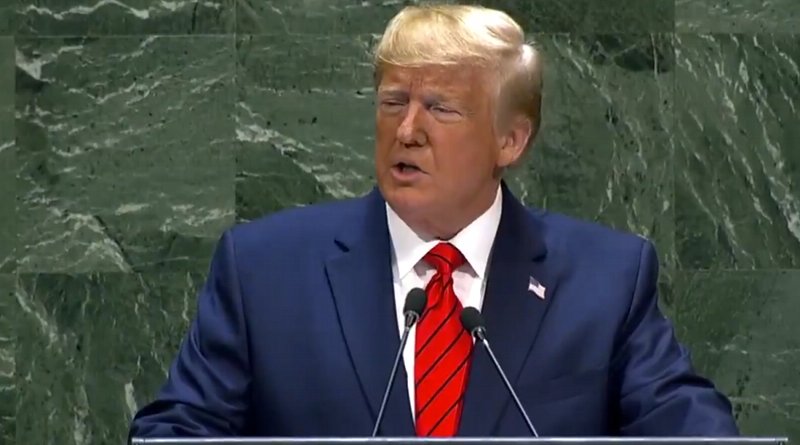With Little Possibility Of US-Iran Talks, Conflict Could Escalate – Analysis
After the deadly drone attacks on the world’s largest oil processing plant and a major oil field in Saudi Arabia on September 14, the US has announced beefing up Saudi air defences by sending 1 x Patriot missile battery, 4 x Sentinel radars and 200 support troops.
By Lt Gen PC Katoch (retd)*
After the deadly drone attacks on the world’s largest oil processing plant and a major oil field in Saudi Arabia on September 14, the US has announced beefing up Saudi air defences by sending 1 x Patriot missile battery, 4 x Sentinel radars and 200 support troops.
According to the Pentagon, an additional THAAD missile defence system and two additional Patriot missile batteries can also be sent, if required.
The Pentagon has also sought international support through a statement saying, “Other countries have called out Iranian misadventures in the region, and we look for them to contribute assets in an international effort to reinforce Saudi Arabia’s defence.”
Some 60,000 US troops are reportedly already in the Middle East region.
Houthi rebels of Yemen had claimed responsibility for attacking the Saudi oil facilities. However, Saudi Arabia and the US have blamed Iran.
US Defence Secretary Mark Esper stated on September 27, “It is clear that the weapons used were Iranian-produced and were not launched from Yemen.” He added that all signs indicate that “Iran was responsible for the attack.”
During the 74th session of the UN General Assembly held in New York, Britain, France and Germany also accused Iran for attacking Saudi oil facilities.
Addressing the UNGA on September 25, Iranian President Hassan Rouhani demanded that the US should “pay more” for any agreement that goes beyond the 2015 JCPOA.
Rouhani refused a closed door meeting with US President Donald Trump on the sidelines of UNGA. This was expected, despite French President Emmanuel Macron holding parleys with his US and Iranian counterparts over two days at the UN, because of the fresh sanctions imposed on Iran, which Washington described as “the harshest ever in history”.
Rouhani has made it clear that he will refuse talks as long as the US maintains its economic pressure, by stating at the UNGA, “I would like to announce that our response to any negotiation under sanctions is negative”.
Since there is hardly any possibility of Trump easing sanctions soon, there is little chance of an Iran-US dialogue in the foreseeable future.
There are two corollaries to these developments. First, German Chancellor Angela Merkel earlier wanted Trump to rejoin the JCPOA. Second, Trump, who has thrice indicated his keenness to mediate on Kashmir, despite India clarifying it is an internal matter of India, rebuffed a journalist’s query on French President Macron’s offer to mediate between Iran and the US, saying he did not need intermediaries.
“They (Iran) know who to call. Who are you gonna call – Ghostbusters?” Trump retorted.
Mike Esper said the fresh US deployment to beef up Saudi Arabia’s defences is a “first step” toward addressing Iran’s increasingly violent acts in the region; aimed at sending a clear message that Washington supports its partners.
Now reports have emerged that Trump is contemplating a second cyber-attack to punish Iran. Interestingly, the US itself considers a cyber-strike an “act of war”. But The US views the attack on Saudi oil facilities as an act of war by Iran, whether by design or default.
The US had cyber-attacked Iran on June 20 this year, reportedly wiping out a critical database used by Iran’s paramilitary arm to plot attacks against oil tankers, thereby degrading Iran’s ability to covertly target shipping traffic in the Persian Gulf.
Two months later, in August, US officials were quoted as saying that Iran was still trying to recover information destroyed in the cyber-strike and restart some of the computer systems, including military communications, taken off-line. Within the Trump administration, there were also discussions whether benefits of the covert operation outweighed the costs.
Trump, perhaps, is weighing a second cyber-strike after reports surfaced of Iran crossing the JCPOA limit of nuclear enrichment. After all, the US-Israel ‘Stuxnet’ attack during the Obama administration did cripple Iranian nuclear enrichment centrifuges.
Cyber attacks can also be used to cripple Iran’s critical infrastructure, including oil fields, refineries and military installations. However, what Iran’s present capacity is to withstand such attacks and what aces it has up its sleeve to respond remains ambiguous. Interestingly, the US has never dared to cyber-attack North Korea, despite the UN stating that North Korea has committed cyber attacks in 17 countries.
The US deliberately let China make Pakistan a nuclear state; Pakistan boasts of possessing the Sunni Islamic Bomb. There are reports that Pakistan has a package of nuclear weapons ready to be shipped to Saudi Arabia should Iran go nuclear.
Turkey’s Recep Erdogan is questioning why it should not go nuclear like Pakistan – and it may soon, clandestinely. In this backdrop, how does Iran, as the leading Shia nation, defend itself? Hasn’t this situation been created by short-sighted policies of the West, while trumpeting non-proliferation? And how long can global powers defend their mainland while playing mayhem elsewhere selectively?
British Prime Minister Boris Johnson says he would consider joining the US-led effort to bolster Saudi defences – he likely will, to repay Trump supporting him on Brexit. Then Saudi Arabia will attack Yemen, where Pakistan also contributed paramilitary forces for the ground invasion.
Houthis may be using Iranian-origin weaponry, but they don’t require Tehran’s directions on how to respond to a Saudi invasion, having already demonstrated asymmetric prowess in hitting targets over long ranges.
The Pentagon’s concept against cyber-attack includes a physical, military response. So why would Iran not respond similarly to cyber-attacks which, not necessarily, means conventional war? The trigger of escalation, therefore, is with Trump.
*About the author: The author is Distinguished Fellow, United Service Institution of India
Source: This article was published by South Asia Monitor

